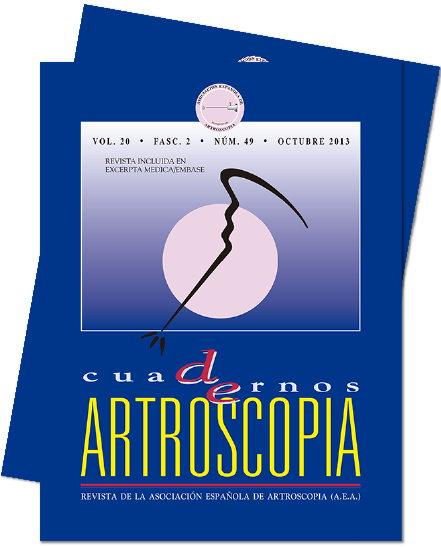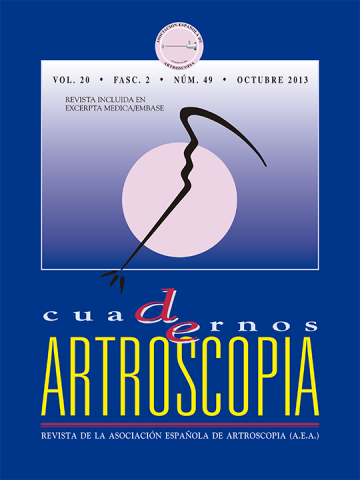Resumen:
Objetivo: el objetivo principal de este trabajo es el estudio y cuantificación del pivot-shift (PS) mediante el sistema de “navegación” de Orthopilot® durante la cirugía del LCA.
Material y método: estudio clínico transversal sobre 17 pacientes intervenidos por lesión crónica del LCA. Se realizaron pruebas de estabilidad en un solo plano y el PS lateral. Al analizar los test de laxitud del “navegador”, en un paciente se optó por reconstruir únicamente el fascículo posterolateral, y a otro paciente se le añadió una tenodesis lateral a la reconstrucción intraarticular. Para la reconstrucción estándar se utilizó la técnica anatómica con injerto de isquiotibiales.
Resultados: se describen los tipos de curva representadas por el navegador durante el PS. Los valores medios de cajón anterior, rotación interna y rotación externa a 30° (test en un solo plano) antes y después de la reconstrucción fueron de 13,3 mm (± 2,16), 15,2° (± 4,34), 20,1° (± 4,87) y 5,1 mm (± 1,54), 11,6° (± 2,34), 16,4° (± 4,89), respectivamente. Los valores máximos de traslación y rotación durante la maniobra del PS fueron de 14 (± 4,54) y 17,4 (± 4,68) en la exploración inicial, descendiendo a 13,5 (± 5,21) y 13,1 (± 4,1) en la exploración final al terminar la ligamentoplastia (p < 0,05 para el valor rotacional).
Conclusiones: la “navegación” permite definir y cuantificar la inestabilidad en rodillas LCA con deficiencia del LCA. El análisis individualizado de la laxitud de cada paciente podría determinar el tipo de estabilización quirúrgica necesario.
Abstract:
Purpose: the main purpose of this study is the analysis and quantification of the pivot-shift (PS) phenomenon with the Orthopilot® navigation system before and after anatomic ACL ligamentoplasty.
Matherial and method: study of 17 patients operated for chronic primary ACL rupture. The stability was studied with monoplanar test and the lateral pivot-shift test. After studying navigated laxity test, one patient only received an augmentation of the posterolateral bundle and other one had the intra-articular ACL reconstruction associated with lateral tenodesis. The remaining 14 patients were treated with an anatomic single bundle reconstruction with hamstrings.
Results: we describe the types of curves represented by the navigator during the PS. The mean values of anterior translation, internal rotation and external rotation at 30° (uniplanar tests) before and after reconstruction were 13.3 mm (± 2.16), 15.2°(± 4.34), 20.1° (± 4.87) y 5.1 mm (± 1.54), 11.6° (± 2.34), 16.4° (± 4.89), respectively. The maximum anteroposterior (AP) translation and rotation during the PS test were 14 (± 4,54) y 17,4 (± 4,68) before reconstruction, decreased to 13,5 (± 5,21) y 13,1 (± 4,1) in the postoperative examination (rotational value p < 0.05).
Conclusions: computer navigation allows to assess and define the type of pathological laxity in ACL-deficient knees. Individualized approach of laxity patterns could lead to a personalization of surgery.
Keywords:
Anterior cruciate ligament reconstruction
ACL
Pivot-shift
Navigation
Computer assisted surgery




